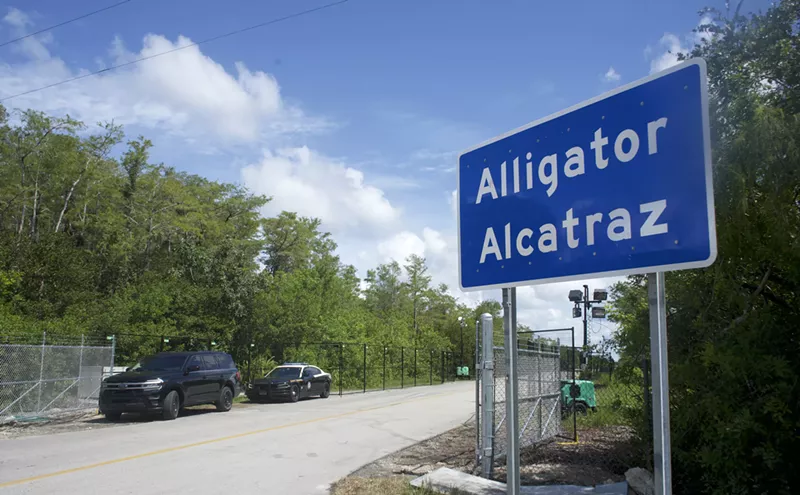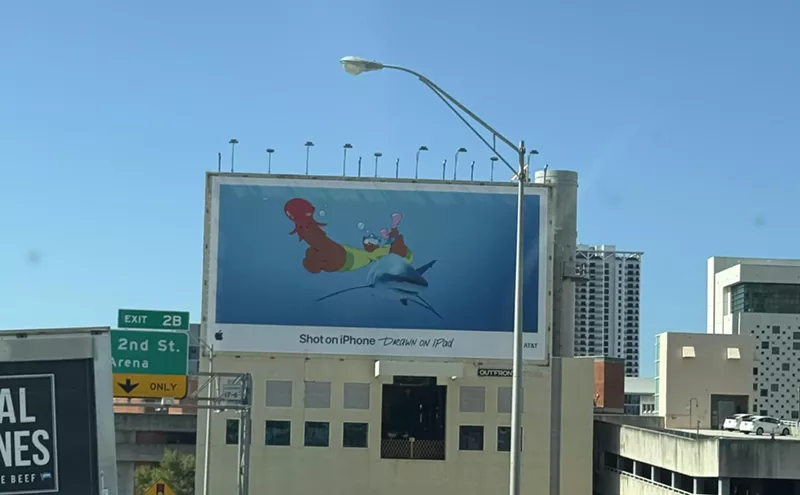"He's not here and that's bad," intones activist Keith Ivory, master of ceremonies. "The mayor dissed us. But he stepped to the wrong people." Ivory turns the mike over to a group of women, mostly from Gwen Cherry, a public housing complex built in several locations along the axis of Northwest 23rd Street, from NW 12th Avenue to NW 23rd Avenue. That puts it squarely in the center of Allapattah, a seedy, vibrant mash of rundown apartments and homes, wholesale produce and meat markets, auto shops, junkyards, and the Jackson Memorial Hospital complex. In recent decades a pit of crime, homelessness, trash, and unbelievably toxic environmental conditions, Allapattah is looking a little better these days because the city has cleaned up the worst of the industrial trash, and disbanded the shantytown of homeless who'd camped near the railroad tracks that run through its heart.
Unfortunately the rats that thrived in the chaos are still there, if anything more visible to residents because they've been driven from the trash heaps in the alleys to the living quarters of the people. Allapattah, population roughly 40,000, is one of Miami's poorest neighborhoods. While Gwen Cherry is largely peopled by African Americans, most of the neighborhood around them is Hispanic -- Cubans, Nicaraguans, Dominicans, Hondurans. Matronly Rebecca Walker begins the complaints, her eyes big and serious behind her glasses, as she tells about an older man in her neighborhood who fell asleep while eating sweet potatoes; he woke up, "and a rat had eaten his heel off! He's in the hospital and they're not looking for him to live," she ends sadly.
Walker's story is the most shocking of the night, but plenty of people testify about the rats they've seen and heard scuttling along the walls of their buildings, under cars, on the stairs, or backing down cats in the parking lots, like furry little gangsters in a turf war. Portia Williams delivers this hyperbolic testimonial: "I went to the Walgreens the other day and looked over in the lot and there was six or seven rats. They was playing ball. They were eating chicken from the chicken house. They was drinking soda from the Walgreens. Listen, it was a rat party! They looked at me like, 'You want to come?'"
Then the women turn back to the picture of Manny Diaz, reading off a list of demands they would have asked Diaz to commit to, if he were there. (The residents sent a letter to his office in October, and also personally asked him to attend. A mayoral aide notified them the day before the November 13 meeting that the mayor couldn't come, offering to send staff instead. The group refused, demanding that Diaz hear about the rats firsthand. "It was a take-it-or-leave-it," sighs Diaz policy advisor Javier Fernandez, acknowledging that the group's clever tactic would generate more interest from citizens than the bashing of a mere lackey.) The demands are simple. They want the city to add an environmentally sound rat abatement program to Diaz's much-touted Clean Up Miami campaign. They want the city to increase code enforcement of trash-dumping businesses in the area. And they want residents tested for health problems related to the many environmental hazards in their neighborhood.
"Rodents need three things," as Trevor Coke, an environmental supervisor at the county health department, later explains. "Food, water, and harborage [shelter]." Allapattah, of course, has all three in abundance. Coke reveals that the county used to have a rat-destroying program years ago, but stopped because of the liability of distributing rat poison in places where other mammals, like cats and kids, could get into it. Coke is thoughtful. "You know, we are thinking about getting into abatement, the killing of rodents. But we are thinking about doing it a different way."
Getting rid of the rats is, for these folks, step one of a broader campaign for environmental justice. Calling themselves Residents of Allapattah for Safety and Health (R.A.S.H.), they want to address many other health problems found in poor communities, which have historically served as convenient dumping grounds for wealthier communities around them. Inner-city Miami has a high concentration of properties polluted with chemicals, oil and gas, and other nasties left over from years of heavy-duty use by businesses now long gone. Large sections of poor Miami have been identified as needing expensive cleanups before housing or shops can be built on them. Gwen Cherry resident Sheila Norman and her neighbors worry about what's in the ground, the water, and the air around them. Deborah Green wonders whether the persistent colds her children repeatedly come down with are actually caused by pollution, or are respiratory diseases spread through rat droppings. She remembers the horrors of growing up in a rat-infested project in Liberty City, and wants better for her five kids and granddaughter. "I will fight for my children to the bitter end," she says grimly.
Green, Norman, and the others have elicited the help of County Commission Chairwoman Barbara Carey-Shuler, who called the county health department (which handles rat problems) on their behalf, and plans to meet with Mayor Diaz in the near future. "I felt that it is something we need to do," she says. "It's not just about rats. It's about safety and health." Diaz policy advisor Fernandez claims Diaz also wants to help. "We definitely don't want people living in unsanitary conditions," he says. "We want to make Miami America's cleanest city, not America's most infested." Fernandez is a little unhappy about how the meeting made Diaz look bad, but says he understands venting sessions like it help disenfranchised people feel empowered. "There are some areas there that have problems," he admits. "We are perfectly willing to target cleanups in those areas. At some point we would like to get beyond the adversarial [stage] to actually get to doing the work." On the larger issue of environmental justice, Fernandez adds that the city is going after and getting federal grants, to clean up the city's many polluted properties.
Back at Ebenezer Church, the meeting ends with a call to action from Keith Ivory. "The mayor didn't come," he goads. "He's on the run, like a rat." The point isn't so much to vilify Manny Diaz as it is to generate sufficient passion in the residents to go the distance. Ivory leads the audience in a reading of the classic Black Power folk poem, "Whitey on the Moon." "A rat done bit my sister Nell. With Whitey on the moon. Her face and arms began to swell. And Whitey's on the moon. I can't pay no doctor bill. But Whitey's on the moon. Ten years from now I'll be payin' still. While Whitey's on the moon..."












